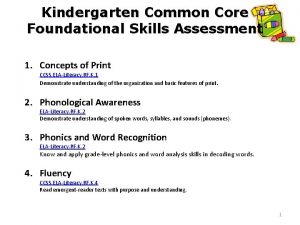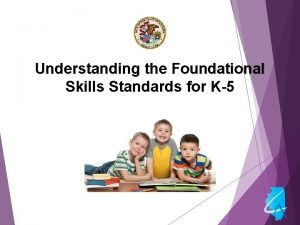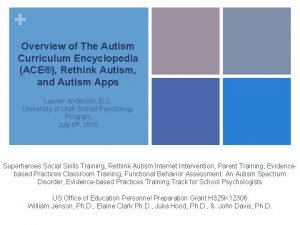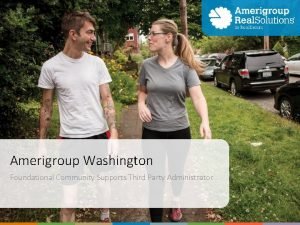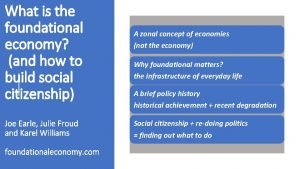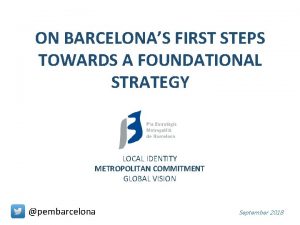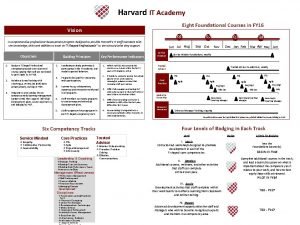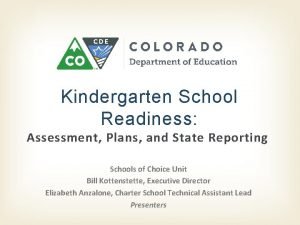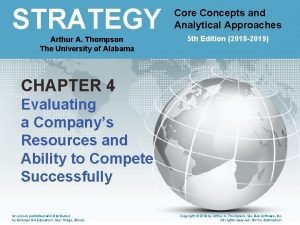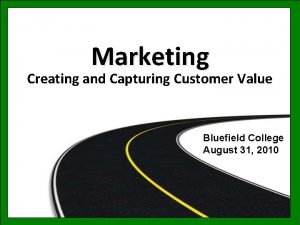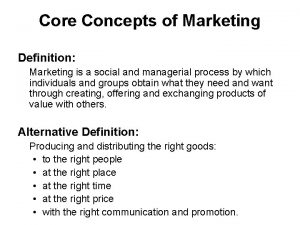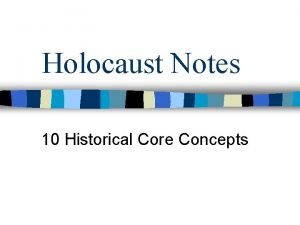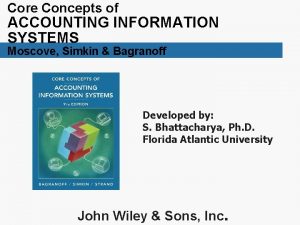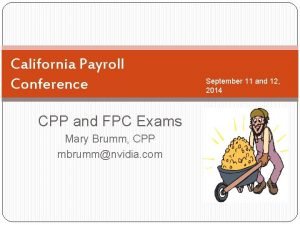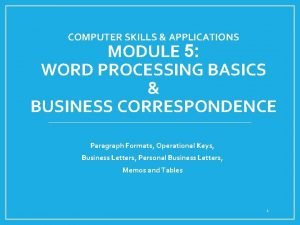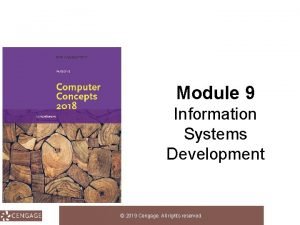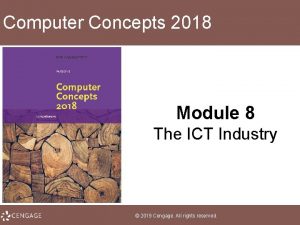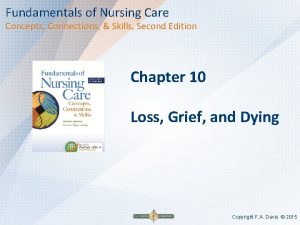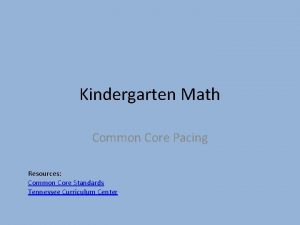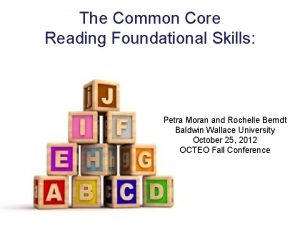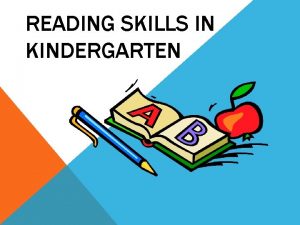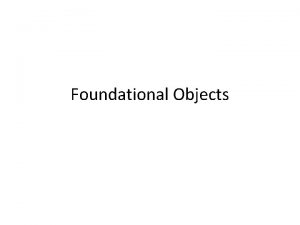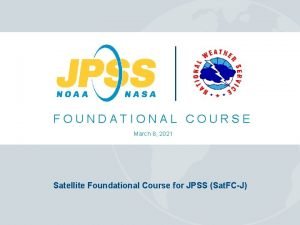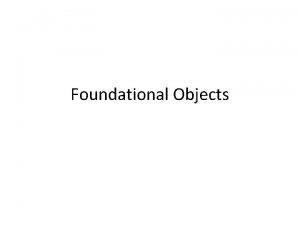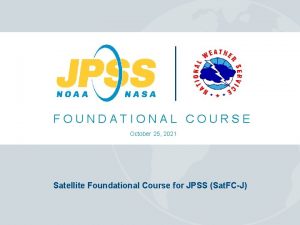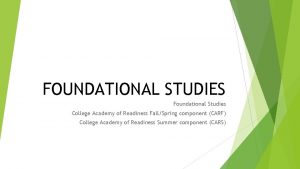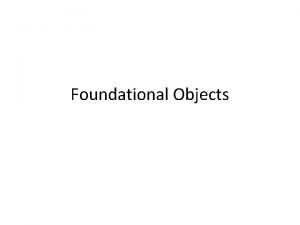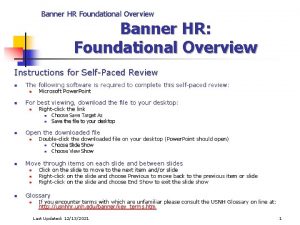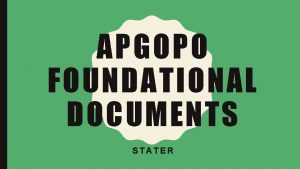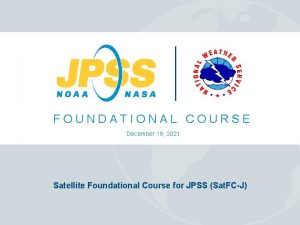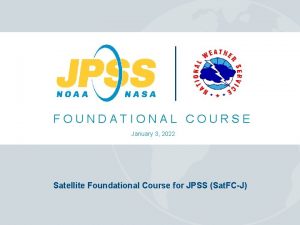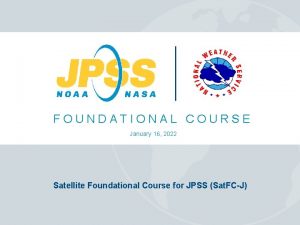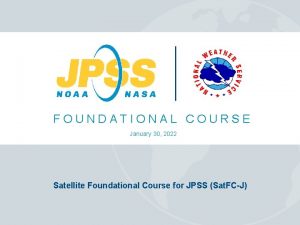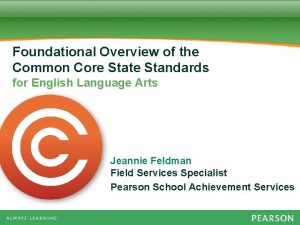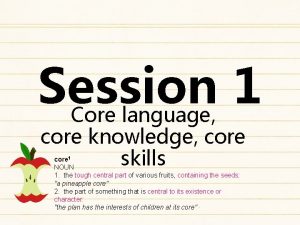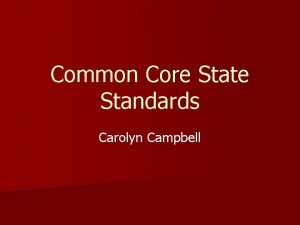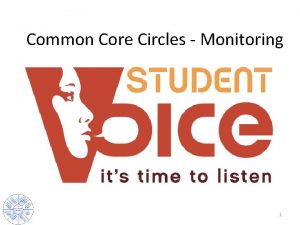Kindergarten Common Core Foundational Skills Assessment 1 Concepts


























- Slides: 26

Kindergarten Common Core Foundational Skills Assessment 1. Concepts of Print CCSS. ELA-Literacy. RF. K. 1 Demonstrate understanding of the organization and basic features of print. 2. Phonological Awareness ELA-Literacy. RF. K. 2 Demonstrate understanding of spoken words, syllables, and sounds (phonemes). 3. Phonics and Word Recognition ELA-Literacy. RF. K. 2 Know and apply grade-level phonics and word analysis skills in decoding words. 4. Fluency CCSS. ELA-Literacy. RF. K. 4 Read emergent-reader texts with purpose and understanding. 1

Resources used in Developing the Foundations Kindergarten Assessment • For general guidelines of backward mapping to understand Kindergarten CCSS Foundation Skills, see Common Core Curriculum Mapping Project (www. commoncore. org). • For understanding a continuum of learning, see, Karin K. Hess, NCIEA, Project Director and Principal Author Jacqui Kearns, NAAC at UKY, Principal Investigator December 2011 • For Common Core Foundation Skills review in kindergarten assessment, see Literacy Resources, Inc. , 2013 assessments • For understanding the developmental continuum for foundation skills in reading, see, Reading First Reading Based Skills, Creative Teaching Press, 2003 • For phoneme blending, onsets and rimes, see Houghton Mifflin routines, a Legacy of Literacy 2008 • For a general overview of kindergarten foundational skills, see, Big Ideas in Kindergarten Early Reading, University of Oregon • For a view of an instructional model of early reading, see, www. soprislearning. com/literacy/sound-partners • For categorizing general kindergarten assessment continuums, see Matching Assessment and Instruction , Anne Mc. Gill-Franzen New York Scholastic For Read to Write in the CCSS Foundational Skills, see, The Reading and Writing Project Letter Sound Identification http: //readingandwritingproject. com/public/themes/rwproject/resou rces/assessments/reading/letter_sound_identification/letter_sou nd_identification_implications. pdf • • To read more about how grade text complexity affects kindergarten and high frequency word recognition, see, http: //www. heinemann. com/fountasandpinnell/pdfs/White. Paper Text. Grad. pdf • For an extensive read of foundational skills, activities and strategies , see Teaching Reading Strategies, by Mark Pennington, from Pennington Publishing, 2008 • For news on the latest practices and literacy / developmental research, see, National Association for the Education of Young Children (NAEYC) http: //www. naeyc. org/content/about-naeyc • Adams, M. J. (1996). Beginning to read: Thinking and learning about print. Cambridge, MA: MIT Press. • Ehri, L. C. (2005). Learning to read words: Theory, findings, and issues. Scientific Studies of Reading, 9(2), 167– 188. • Vandervelden, M. C. , & Siegel, L. S. (1995). Phonological recoding and phoneme awareness in early literacy: A developmental approach. Reading Research Quarterly, 30(4), pp. 854875. 2

Kindergarten Foundational Standards Print Concepts: Phonological Awareness Phonics and Word Recognition Fluency CCSS. ELA-Literacy. RF. K. 1 Demonstrate understanding of the organization and basic features of print. CCSS. ELA-Literacy. RF. K. 2 Demonstrate understanding of spoken words, syllables, and sounds (phonemes). CCSS. ELA-Literacy. RF. K. 3 Know and apply grade-level phonics and word analysis skills in decoding words. CCSS. ELALiteracy. RF. K. 4 Read emergent-reader texts with purpose and understanding. CCSS. ELA-Literacy. RF. K. 1. a Follow words from left to right, top to bottom, and page by page. CCSS. ELA-Literacy. RF. K. 1. b Recognize that spoken words are represented in written language by specific sequences of letters. CCSS. ELA-Literacy. RF. K. 1. c Understand that words are separated by spaces in print. CCSS. ELA-Literacy. RF. K. 1. d Recognize and name all upper- and lowercase letters of the alphabet. CCSS. ELA-Literacy. RF. K. 2. a Recognize and produce rhyming words. CCSS. ELA-Literacy. RF. K. 2. b Count, pronounce, blend, and segment syllables in spoken words. CCSS. ELA-Literacy. RF. K. 2. c Blend and segment onsets and rimes of single-syllable spoken words. CCSS. ELA-Literacy. RF. K. 2. d Isolate and pronounce the initial, medial vowel, and final sounds (phonemes) in three-phoneme (consonant-vowelconsonant, or CVC) words. 1 (This does not include CVCs ending with /l/, /r/, or /x/. ) CCSS. ELA-Literacy. RF. K. 2. e Add or substitute individual sounds (phonemes) in simple, one-syllable words to make new words. CCSS. ELA-Literacy. RF. K. 3. a Demonstrate basic knowledge of one-to-one letter-sound correspondences by producing the primary sound or many of the most frequent sounds for each consonant. CCSS. ELA-Literacy. RF. K. 3. b Associate the long and short sounds with the common spellings (graphemes) for the five major vowels. CCSS. ELA-Literacy. RF. K. 3. c Read common high-frequency words by sight (e. g. , the, of, to, you, she, my, is, are, does). CCSS. ELA-Literacy. RF. K. 3. d Distinguish between similarly spelled words by identifying the sounds of the letters that differ. 3

Kindergarten Common Core Foundational Skills Assessment Directions for… 1. Concepts of Print RF. K. 1: Demonstrate understanding of the organization and basic features of print. Teacher Directions and Administration Materials for Concepts of Print You will need these items: Teacher Copies (In Teacher Directions) • • 1 Per Student Letter Naming Record Form for scoring 1 Per Student Concepts of Print Checklist for scoring Student Copies/Student Testing Prompts • Question #1 Student Prompt A p. 1 and p. 2– Letter Naming • Questions # 2 – 7 Student Prompt B of “I Flew My Kite. ” • Question # 8 – Student Prompt C- Short and Long Words • Questions #9 – 13 Teacher selects any familiar story. Visit: Common Core Curriculum Mapping Project www. commoncore. org Print Concepts: CCSS. ELA-Literacy. RF. K. 1 Demonstrate understanding of the organization and basic features of print. CCSS. ELA-Literacy. RF. K. 1. a Follow words from left to right, top to bottom, and page by page. CCSS. ELA-Literacy. RF. K. 1. b Recognize that spoken words are represented in written language by specific sequences of letters. CCSS. ELA-Literacy. RF. K. 1. c Understand that words are separated by spaces in print. CCSS. ELA-Literacy. RF. K. 1. d Recognize and name all upper- and lowercase letters of the alphabet. 4

Kindergarten Common Core Foundational Skills Assessment Directions for… 2. Phonological Awareness RF. K. 2: Demonstrate understanding of spoken words, syllables, and sounds (phonemes). . Teacher Directions and Administration Materials for Phonological Awareness You will need these items: Teacher Copies (In Teacher Directions) • 1 Per Student Phonological Awareness Checklist Student Copies/NO Student Testing Prompts • Questions # 1 – 13 do not required student prompts (auditory) Phonological Awareness CCSS. ELA-Literacy. RF. K. 2 Demonstrate understanding of spoken words, syllables, and sounds (phonemes). CCSS. ELA-Literacy. RF. K. 2. a Recognize and produce rhyming words. CCSS. ELA-Literacy. RF. K. 2. b Count, pronounce, blend, and segment syllables in spoken words. CCSS. ELA-Literacy. RF. K. 2. c Blend and segment onsets and rimes of single-syllable spoken words. CCSS. ELA-Literacy. RF. K. 2. d Isolate and pronounce the initial, medial vowel, and final sounds (phonemes) in three-phoneme (consonant-vowel-consonant, or CVC) words. 1 (This does not include CVCs ending with /l/, /r/, or /x/. ) CCSS. ELA-Literacy. RF. K. 2. e Add or substitute individual sounds (phonemes) in simple, one-syllable words to make new words. 5

Kindergarten Common Core Foundational Skills Assessment Directions for… 3. Phonics and Word Recognition RF. K. 3: Demonstrate understanding of spoken words, syllables, and sounds (phonemes). . Teacher Directions and Administration Materials for Phonics and Word Recognition You will need these items: • Phonics and Word Recognition Awareness Checklist Student Copies/Student Testing Prompts • Question #1 - Letter-Sound Recognition Student Prompt D • Question #2 – High Frequency Words Student Prompt E • Question #3 – “Sounding Out” short and long vowel words. Prompt F Phonics and Word Recognition CCSS. ELA-Literacy. RF. K. 3 Know and apply grade-level phonics and word analysis skills in decoding words. CCSS. ELA-Literacy. RF. K. 3. a Demonstrate basic knowledge of one -to-one letter-sound correspondences by producing the primary sound or many of the most frequent sounds for each consonant. CCSS. ELA-Literacy. RF. K. 3. b Associate the long and short sounds with the common spellings (graphemes) for the five major vowels. CCSS. ELA-Literacy. RF. K. 3. c Read common high-frequency words by sight (e. g. , the, of, to, you, she, my, is, are, does). CCSS. ELA-Literacy. RF. K. 3. d Distinguish between similarly spelled words by identifying the sounds of the letters that differ. 6

Kindergarten Common Core Foundational Skills Assessment Directions for… 4. Fluency RF. K. 4 Read emergent-reader texts with purpose and understanding. Teacher Directions and Administration Materials for Fluency You will need these items: • Fluency Checklist Student Copies/Student Testing Prompts Fluency CCSS. ELA-Literacy. RF. K. 4 Read emergent-reader texts with purpose and understanding. • Quarterly Decodable Text Student Prompt G #1– 4 Student decodable text prompts consist of the short vowel focus letter for each quarter and are provided or teachers may use their own decodable texts that have the same short focus vowel for that quarter. 7

Foundations Assessment Checklists for Scoring 1 per Student 8

Student Name: ______________ Grade_____ Year_____ Teacher_________ Concepts of Print Checklist RF. K. 1: Demonstrate understanding of the organization and basic features of print. #1 Upper and Lower-Case Letter Naming Record Form Recognize and name all upper- and lowercase letters of the alphabet (RF. K. 1 d) Circle letters the student does not name correct. Continue to assess those letters. QTR 1 QTR 2 Proficiency ___/13 QTR 3 Proficiency ___/26 QTR 4 Proficiency ___/40 Proficiency ___/52 Capital Lower-Case S s H h D d J j M m V v Z z U u R r C c W w T t P p Y y B b G g -X -x N n F f E e A a L l O o K k Q q I i 9

Concepts of Print Checklist continued… Quarter 1 Quarter 2 Quarter 3 Quarter 4 For Questions 2 – 7 Use Student Copy B 2 Points to 3 to 4 letters on a page. (RF. K. 1 a) Yes No 3 Point to 3 or 4 words on the page. (RF. K. 1 a) Yes No 4 Points to a sentence. (RF. K. 1 a) Yes No 5 Points left to right as teacher reads in a 4 -5 word sentence. (RF. K. 1 c Yes No 6 Points to 2 or more capitals. (RF. K. 1 c) Yes No 7 Points to 2 or more periods. (RF. K. 1 c) Yes No For Question 8 use Student Copy C 8 Long and Short words: Check if correct. (RF. K. 1 c) Cover the words you are not referring to. Ask, “Which word is: Anthony___? Kate___? Baseball___? Elf___? Hippopotamus___? ” ____of 5 ____ of 5 For Questions 9 – 13 use any Teacher Selected Book 9 Tracks words from top to bottom. (RF. K. 1 c) Yes No 10 Tracks words page by page. (RF. K. 1 c) Yes No 11 Points to the title. (RF. K. 1 a) Yes No 12 Points to the author’s name and states purpose. (RF. K. 1 a) Yes No 13 Points to the illustrator’s name and states purpose. (RF. K. 1 a) Yes No 10

RF. K. 2: Demonstrate understanding of spoken words, syllables, and sounds (phonemes). Phonological Awareness Checklist 1 Isolates and pronounces (in CVC words) initial consonant sounds heard (RF. K. 2 d). This is an oral assessment, and no student copy is needed. Teacher: “Tell me the first sound you hear in each of the words. ” Circle words to show correct response. Mad rock top hot map Apple kite seal lamp bike Lab Keep Noon Fuss buzz Bird Dark Leaf Storm can 2 Identifying Final Sounds (RF. K. 2 d) Teacher “I will say a word you will tell me the final sound in the word. Students can use “Punch It Out. ” (Model a word for the student not on the list) cat hat 3 Identifies rhymes that have the same last rime (RF. K. 2 c). No student copy is needed. Teacher: “Tell me if these two words have the same last “rhyme” (rime). ” (Model a word for the student not on the list) pig wig box lip man mat sun run let bet mop top boat coat hit sit ham get 4 Blend onset and rime. Teacher: “Listen as I say a word in parts. Then say the whole word. ” (Model a word for the student not on the list). S-un L-ip B-ed R-ag D-ime W-eb M-ad F-eet F-ox C-up Sat Lap Big Run dig 5 Segments onset and rime. Teacher: “Listen as I say a word. Then say the first part and the last part. ” (Model a word for the student not on the list). Well Man Fun Kit can 6 Blend the syllables to make a word (RF. K. 2 b) Teacher: “I am going to say a word in parts, and you will blend what I say into a real word. ” (Model 1 -2 words for the student not on the list). Pen. Cil Rain. Bow Pop. Corn Black. Board Sidewalk Pa. Per Nap. Kin Tick. Et Welcome Sister QTR 1 QTR 2 QTR 3 QTR 4 __/10 __/10 __/10 __/10 __/10 11

Phonological Awareness Checklist Identifying Medial Sounds RF. K. 2 d 7 8 Teacher “I am going to say a word. Can you tell me the sound you hear in the middle of the word? ” Teacher says the word and students isolate the vowel sound. Rhyme Production (RF. K. 2 d) Teacher “Tell me a word that rhymes with the word I say. *Nonsense words can be accepted. ” (Model 1 -2 words) Blending Phonemes : Teacher: “Listen to the sounds; blend the 9 sounds to make a word. sounds together to make a word. Teachers say the sounds separately and students are expected to blend the sounds into a word. ” (Model 1 -2 words) 10 Segmenting Phonemes: Teacher: “I will say a word and you say the sounds you hear. ” (Model 1 -2 words). Segmenting Syllables RF. K. 2 b 11 12 13 QTR 1 continued Teacher: “I am going to say a word and I want you to say the words in syllables (or word parts). ” Circle if student can segment word into two syllables. Adding & Substituting Phonemes RF. K. 2 e Teacher says the rime. Students repeat the rime. Teacher says, “Add /*/ at the beginning and the word is? Substituting Phonemes: Teacher says the word. Students repeat the word. Teacher says, “Change the /*/ to /*/ and the word is? (/*/ = say letter sounds) Man big sun jet hot Dug fan mix bed jog mop ham tub hip Red pat Fun dog net Fish h-a-m n-e-ck f-u-n s-i-t j-o-b b-u-g k-i-d t-a-g m-o-m l-e-d not dug van has Chip fix Box tell rub nut tiger candy finish upside hippo yellow paper pencil bobcat baby _at _ig _op _un QTR 2 QTR 3 QTR 4 ___/10 ___/10 _ed (add b) (add p) (add m) (add r) (add f) Van /m/ Hot /n/ Bun /s/ Beg /l/ Sip /r/ __/10 12

Student Name: ______________ Grade_____ Year_____ Teacher_________ Phonics and Word Recognition Checklist RF. K. 3 Know and apply grade-level phonics and word analysis skills in decoding words. #1 Letter Sound Record Form Demonstrate basic knowledge of one-to-one letter-sound correspondences by producing the primary sound or many of the most frequent sounds for each consonant (RF. K. 3 a, b). Circle letters that student do not say the sounds for correctly. Continue to assess those letters. Digraphs: Assess throughout the year although they are introduced in quarter two. Assess most common sounds of digraphs – shoe – wheel – thumb - chair QTR 1 QTR 2 QTR 3 QTR 4 Proficiency ___/9 Proficiency ___/25 Proficiency ___/36 Lower-Case s h d j m v z u as short ___ u as long ___ r c as /k/ ____ c as /s/_____ w t p y b g -x as /ks/ sound ___ n f e as short ___ e as long ___ a as short ___ a as long ___ l o as short ___ o as long ___ k q i as short ___ i as long ___ sh_____ wh_____ th______ ch________ 13

Phonics and Word Recognition Checklist continued… Directions: Circle only incorrect responses. Continue to assess incorrect responses each quarter as needed. High Frequency Words (RF. K. 3 c) note: words “new” to kindergarten from the high frequency Dolsch word list are highlighted. 2 I see my like a to and go is here at can for have said the play she we do are he look it me Quarter 1 Quarter 2 Quarter 3 Quarter 4 Proficiency 9 Proficiency 19 Proficiency 25 Correct____ Correct___ Correct____ Correct___ Correct ___ Short Vowel Words Distinguish between similarly spelled words by identifying the sounds of the letters that differ RF. K. 3 d Recognize and say aloud the one to one correspondence between short vowel graphemes (a, e, i, o, u) and their sounds (/ă/, /ě/, /ĭ, /ŏ/, /ŭ/) in VC (e. g. , am) and CVC (e. g. , sit) words. “Blend or Sound-Out each word. ” In quarter 1 student may not be able to blend entire words, but should have the short vowel a sound correct. 3 Sam man rat tab bat hip fit lip Vic Kim dog web box yes zip Jug Gus bug run sun ___/5 ___/5 Long Vowel Words Distinguish between similarly spelled words by identifying the sounds of the letters that differ RF. K. 3 d Recognize and say aloud the one to one correspondence between common long vowel graphemes (a_e, e_e, i_e, o_e, u_e) and their sounds (/ā/, /ē/, /ī/, /ō/, /ū/). she he me we no like ate hole cute sun Fluency Checklist ___/5 Quarter 1 Quarter 2 Quarter 3 Quarter 4 CCSS. ELA-Literacy. RF. K. 4 Read emergent-reader texts with purpose and understanding. 1 Decodable Text for short vowel a words. 2 Decodable Text for short vowel i words. 3 Decodable Text for short vowel e and o words. 4 Decodable Text for short vowel u words. Yes No Yes No Yes No 14

Student Prompts needed for Assessment 1 per Teacher 15

Student Prompt A p. 1: Letter Naming Upper-Case Letters Concepts of Print: Question #1 Student copy [use Concepts of Print Checklist for scoring] The letters are in order from left to right following each quarter’s focus letter names. S N P Q Y U M A G I X R H F D E T V L Z O B C K W J 16

Student Prompt A p. 2: Letter Naming Lower-Case Letters Concepts of Print: Question #1 Student copy [use with Concepts of Print Checklist for scoring] s n p q y u m a g i x r h f d e t v l z o b c k w j 17

Student Prompt B Concepts of Print: Questions # 2 – 7 Student copy [use with Concepts of Print Checklist for scoring] I Flew My Kite I flew my kite. My kite flew high. It got stuck in a tree. My kite broke. 18

Student Prompt C: Long and Short Words Concepts of Print: Student copy Question # 8 Short and Long Words - student copy [use with Concepts of Print Checklist for scoring] Ann Anthony Kate Katherine Ball baseball Elf elephant Hip hippopotamus 19

Student Prompt D: Letter Sound Recognition Phonics and Word Recognition: Question #1 Student copy [use with Letter Sound Record Form for scoring] s n c k z e u m a p q w o sh r a g i y o ch t h f i x j wh b v l d e u th 20

Student Prompt E: High Frequency Words Phonics and Word Recognition Question #2 Student copy [use with Phonics and Word Recognition Checklist for scoring] I see my like a to and go is here at can for have said the play she to we are he look it me 21

Student Prompt F: Blend Short and Long Vowel Sounds Distinguish between similarly spelled words by identifying the sounds of the letters that differ RF. K. 3 d Phonics and Word Recognition Question #3 Student copy [use with Phonics and Word Recognition Checklist for scoring] Short Vowel Words Sam hip dog jug man fit web Gus rat lip box bug tab Vic yes run bat Kim zip sun he ate we home me cute no sun Long Vowel Words she like 22

Student Prompt G 1: Decodable Text Fluency Student copy # 1 – 4 student copy [use with Fluency Checklist for scoring] Quarter 1 I see a man. The man ran. I see Sam ran. Sam and the man ran. I like Sam. I like the man. 23

Student Prompt G 2: Decodable Text Fluency Student copy # 1 – 4 student copy [use with Fluency Checklist for scoring] Quarter 2 Vic and Kim go to the A big . . Vic and Kim will see a pig. 24

Student Prompt G 3: Decodable Text Fluency Student copy # 1 – 4 student copy [use with Fluency Checklist for scoring] Quarter 3 I see a jet. I can have a jet. Tom sees a frog. Will Tom get a frog? Tom will not get a frog. Tom will get a dog. 25

Student Prompt G 4: Decodable Text Fluency Student copy # 1 – 4 student copy [use with Fluency Checklist for scoring] Quarter 4 Gus sees a bug. It is a big bug in the sun. Gus will run to get the bug. But, Gus fell in the mud. Gus will not get the bug. 26
 Foundational skills assessment
Foundational skills assessment Foundational skills definition
Foundational skills definition Ace for autism
Ace for autism Foundational public health services
Foundational public health services Foundational marketing
Foundational marketing Foundational marketing
Foundational marketing Foundational community supports
Foundational community supports Foundational framework meaning
Foundational framework meaning Foundational marketing
Foundational marketing Foundational economy
Foundational economy Foundational strategy
Foundational strategy It academy harvard
It academy harvard Kindergarten readiness checklist colorado
Kindergarten readiness checklist colorado Strategy core concepts and analytical approaches
Strategy core concepts and analytical approaches A simple model of the marketing process
A simple model of the marketing process Core concepts of management
Core concepts of management Core market definition
Core market definition Database basic concepts
Database basic concepts Core concepts
Core concepts Core concepts of accounting information systems
Core concepts of accounting information systems Core payroll concepts
Core payroll concepts Word processing packages
Word processing packages Module 9 computer concepts
Module 9 computer concepts Module 8 computer concepts skills training
Module 8 computer concepts skills training Victorian curriculum history
Victorian curriculum history Fundamentals of nursing care concepts connections & skills
Fundamentals of nursing care concepts connections & skills The brittle, rocky outer layer of earth
The brittle, rocky outer layer of earth
